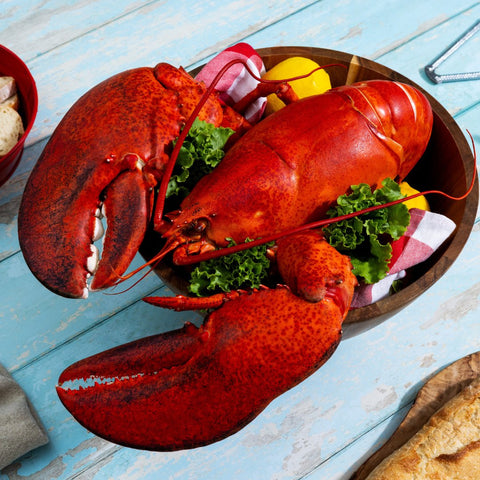Discover the health benefits of eating lobster and find out why it’s so good for you and what nutrition it provides.
Lobster has long been considered a luxury delicacy. It’s found on fine-dining menus around the world, with some restaurants even offering tanks where you can hand-pick your lobster before dining. With a rich, meaty flavor blending sweet, savory, and slightly briny notes, it’s easy to see why it’s such an opulent choice. But lobster isn’t just about flavor and prestige—it also offers impressive nutritional benefits.
Lobster is packed with protein, vitamins, and minerals. In this article, we explore the health benefits of eating lobster, from its calorie and fat content to its overall nutrition profile.
Whether you're a seafood lover looking to eat more lobster, someone focused on healthy eating, or just curious about what makes lobster a nutritious shellfish, this guide will help. Keep reading as we dive into the health benefits—lobster nutrition facts revealed.
1. Lobster Nutrition Facts Explained
Lobster may taste indulgent, but it’s surprisingly nutrient-dense with relatively low calories. It’s an excellent source of protein, Vitamin B2 (for nerve function and red blood cell production), Selenium (a powerful antioxidant), Zinc (for immune health), Copper (for iron absorption and energy production), and Phosphorus (for bone strength).
According to registered dietitian nutritionist Jenny Shea Rawn, M.S., M.P.H., RD, “Lobster contains a small, but not negligible, amount of heart- and brain-health-promoting omega-3 fatty acids.”
A typical 3-ounce portion contains roughly 90 calories, 19g of protein, 1g of fat, 0g of carbohydrates, and less than 70mg of cholesterol—making lobster a great fit for low-carb, keto, or high-protein diets.
Why is protein so important?
Lobster contains all nine essential amino acids, making it a complete protein—just like eggs or chicken. This supports muscle growth, tissue repair, and hormone production. It also aids in satiety and healthy weight management.
2. Calories in Lobster: A Detailed Look
While protein is excellent for energy and satiety, it can be calorie-dense. Fortunately, lobster is low-calorie compared to many other proteins. A 3-ounce portion has about 90 calories, while the same amount of chicken breast contains ~140, salmon ~175, and beef sirloin ~160.
Cooking methods influence calorie counts. Steaming or broiling preserves the low calorie content. Grilled lobster (brushed with oil or butter) increases it to ~100–110 calories, while butter-basted lobster can reach ~200.
3. Lobster's Carb Content Unveiled
Lobster is naturally carb-free, making it ideal for low-carb and keto diets. Unlike mussels or processed meats that may contain carbs, lobster has 0g of carbohydrates.
Be mindful of what you pair it with—sauces, breading, and pasta can quickly add hidden carbs.
4. Lobster Meat: Nutritional Breakdown
Different parts of the lobster offer unique textures and nutrients. The tail and claws are most commonly consumed, each offering distinct benefits.
The lobster tail:
The tail has the highest protein concentration and is rich in Selenium and Vitamin B12. It’s firm, flavorful, and ideal grilled, steamed, baked, or added to pasta and salads.
The lobster claw:
Claw meat is softer with slightly more fat (still low) and rich in Zinc and Copper, which support metabolism and immune function. It’s commonly used in lobster rolls, chowders, and dumplings.
What other parts of the lobster can you eat?
Legs and knuckles provide small amounts of meat, while the liver (Tomalley) is nutrient-rich but should be eaten in moderation due to potential toxin accumulation.
5. Fat Content in Lobster Demystified
Lobster is low in fat—only about 1g per 3-ounce serving. It contains less than 0.2g of saturated fat and trace amounts of heart-healthy Omega-3s.
Cholesterol sits below 70mg per serving, a moderate amount, but dietary cholesterol is no longer considered as impactful as once thought. When enjoyed in moderation and prepared healthily, lobster remains heart-friendly.
Beyond its flavor and indulgence, lobster is a nutritional powerhouse: high in protein, vitamins, and minerals with low calories and carbs. When prepared mindfully—grilled, steamed, or broiled—it becomes a healthy, satisfying choice.
For those aiming to eat clean, boost protein intake, or simply enjoy great seafood, lobster checks all the boxes. Just skip the heavy sauces and go for fresh herbs, lemon, or spice blends.
Of course, the quality of your lobster matters too. Visit Maine Lobster Now for the best selection of live lobsters, tails, fresh meat, and lobster roll kits—ready to elevate your next meal. Now that you know the health benefits, there’s even more reason to indulge!




